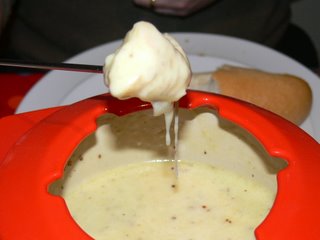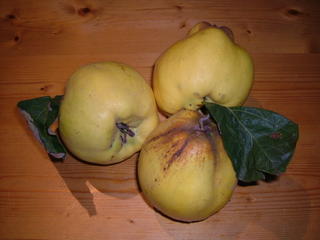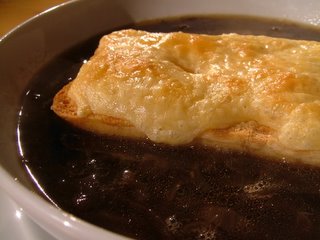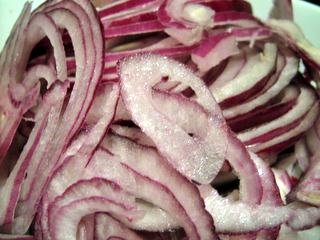 I was born in the 1970s, which makes Dr W’s gift of a fondue set a pleasingly retro and apposite birthday present. Everybody’s parents had a set back in the day which they used for entertaining, and I remember hiding on the landing listening to raucous parties, then sneaking downstairs once they’d all finished and my parents had gone to bed. I would then while away the small hours eating any remaining cheesy bits and polishing off any leftover wine.
I was born in the 1970s, which makes Dr W’s gift of a fondue set a pleasingly retro and apposite birthday present. Everybody’s parents had a set back in the day which they used for entertaining, and I remember hiding on the landing listening to raucous parties, then sneaking downstairs once they’d all finished and my parents had gone to bed. I would then while away the small hours eating any remaining cheesy bits and polishing off any leftover wine.
This, dear reader, is how I became a dipso at the tender age of three.
Fondues are fantastic interactive food. I’ve always held that the foods that require you to *do* something with what’s on your plate, whether it’s wrapping stuff in lettuce leaves, dribbling sauce down your arms or making minty little parcels, taste all the better for the work involved. Convivial and delicious – who could ask for more? You can do all the preparation of the fondue on top of the stove, and move it to the table and its little stand with the flame when you’re ready to eat.
I’ve used a mixture of cheeses here – Emmenthal, Gruyere and Comte. Using these cheeses results in a sweetly nutty fondue, and for me the balance of flavours between the three is pretty much perfect.
Cider’s not traditional here (fondue isn’t from Normandy), but it’s great with the cheese mixture, and hell – once you’ve spent all that money on cheese, I don’t want you impoverishing yourself by using good wine on this dish when you could be impoverishing yourself by drinking it instead. Be sure to mix the cornflour into the cold cider before you start to cook – this will make your fondue smooth and will prevent lumpy or greasy bits, making the cheese and other ingredients coexist in happy, glossy suspension.
I have read warnings that you should not drink too much cold liquid during or after consumption of a cheese fondue for fear of solidifying a bolus of melted cheese in your stomach and finding your digestive system horribly overwhelmed (and presumably dying, eventually, of cheese). If you have read similar warnings I can assure you that you can ignore them. I drank like a fish when we christened the fondue set in the picture at the top, and suffered neither indigestion nor death.
To serve three, you’ll need:
Fondue
200 g Emmenthal
200 g Gruyere
200 g Comte
2 shallots
1 tablespoon butter
1 tablespoon cornflour
300 ml medium dry cider
1 tablespoon grainy Dijon mustard
1 shot-glass Armagnac (this is mere posing – I’ve used it because it’s great with the cider and apples, but it’s not absolutely necessary. You can leave it out if you can’t find any)
To serve
1 large baguette
3 large carrots
3 apples (choose something tart like a Granny Smith)
9 new potatoes (Fingerlings, Pink Fir Apple and other nobbly potatoes are great here)
Chop the raw carrots and apples into bite-sized pieces and set aside. Steam the new potatoes whole for 20 minutes and set aside to cool.
Grate the cheeses and mix together in a large bowl. Dice the shallot very, very finely, and stir the cornflour into the cider in a large jug. (Be careful here – when you stir it in, it will foam, so make sure your jug is large enough to stop any bubbles from escaping.)
Put your fondue pot on the oven hob over a low heat, and sauté the finely diced shallots gently in the butter until they are sweet and translucent (about 10 minutes), stirring all the time so they do not colour. Stir the cider and cornflour mixture well, and pour it over the shallots. Bring everything to a gentle simmer.
Still over a low flame, add the grated cheese to the liquid in the fondue pot a handful at a time, stirring after you add each handful until the cheese is melted and incorporated into the cider mixture. Stir in the mustard and Armagnac with salt and pepper to taste (you may not need any salt – taste the mixture before seasoning). Move the fondue pot to the table, light the little flame, and dig in, dipping hunks of baguette, bits of carrot and apple, and whole, tiny potatoes into the gorgeously savoury cheese sauce.
Asterix in Switzerland (seriously) suggests vaguely sexual forfeits for anyone losing a piece of bread in the fondue pot. I have a better idea – if someone loses the bread, tell them it’s their turn to do the washing-up.
(seriously) suggests vaguely sexual forfeits for anyone losing a piece of bread in the fondue pot. I have a better idea – if someone loses the bread, tell them it’s their turn to do the washing-up.
Oozy, garlicky, herby, smoky and greasy. What’s not to like? Focaccia is the ideal bread to make this sort of baked sandwich from. It’s oily, so it bakes to a gorgeous crisp, and it’s a relatively flat bread, so works well sliced in two horizontally. I like to make my own focaccia (the feeling of an oil-enriched dough, stretchy, silky and puffy with yeast is obscenely – there’s no other word for it – tactile against your palms), but this should work very well with a bought one.
Slice the mozzarella and the artichoke hearts into pieces about ½ cm thick, and put in a mixing bowl. Add the sun-dried peppers, the ham, the garlic, crushed, the herbs, the zest and juice of the lemon and the olive oil with a good grating of pepper (no salt), and mix well so everything is coated with the oil and lemon juice. Cover the bowl and refrigerate for at least an hour (or up to overnight).




